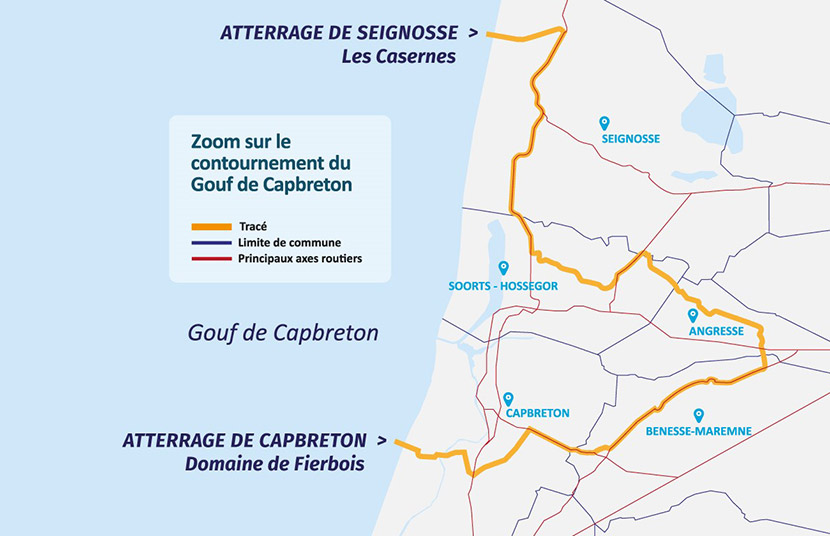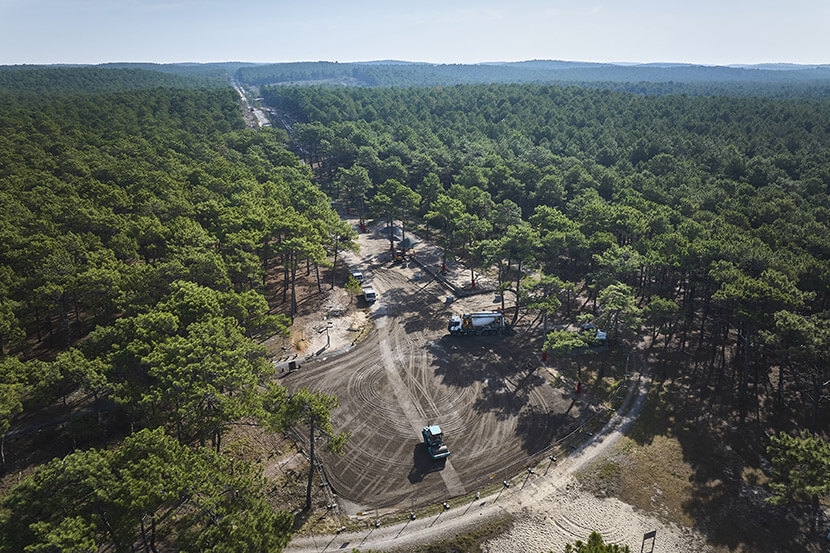Since 2021, in the Landes and the Basque Country, a growing popular mobilization has been organized to fight against a very high voltage line project called the “Bay of Biscay”. Accompanied by the false narrative of transition and sobriety, the strengthening of the European electricity network and the intensification of energy flows are accelerating. For technocracy, the conservation of the system takes precedence over everything else — human well-being, the preservation of living creatures or even the beauty of the landscape.
A devastating project with an uncertain health impact
The RTE (French Electricity Transport Network) and its Spanish equivalent, the REE (Red Eléctrica de España) launched work last October, despite massive and heterogeneous opposition. The objective of the “Bay of Biscay” project: to build a very high voltage line, of 400,000 volts and a power of 2,000 megawatts, between Cubnezais (Gironde) and Gatika (Basque Country).
The arguments put forward by public services and European institutions to sell this ecocidal and dangerous construction for all living beings in the region are essentially based on the increase in energy flows between France, Spain and beyond, as well as on the security of the electrical network. Obviously, the speech is surrounded by greenwashing. This infrastructure project is part of the global decarbonization policy, which, we are told, would aim to mitigate climate change and energy waste. In reality, it is mainly a question of delaying the collapse of the industrial system.
The two public services formed a company to carry out this work. INELFE (for InterÉnection ElectriQUE France-Spain) already implemented a similar project in 2015, the Baixas - Santa Llogaia interconnection, connecting the two countries through the Pyrenees. Even at that time, the unfavourable opinion of local residents to the construction of an overhead line was seen only as an obstacle to be overcome by States and manufacturers.[1]. A compromise is therefore sought by proposing to bury the line to “preserve the landscapes”, as if it were enough to bury them underground for these gigantic infrastructures to cease to exist. The budget exploded. But it also allowed engineers and industrialists to accomplish great technical feats, among other things, to dig an 8 and a half kilometer tunnel through the Pyrenees. To the Spanish Prime Minister to marvel at the destructive power of machines: “There are no more Pyrenees when you decide to boost economic development[2] ”. The environmental consequences of electrical infrastructures are therefore literally hidden under the carpet, which is enough to appease the anger of the majority of residents.[3]. The media present this power line as the triple world record: length, power and voltage[4].
However, the “Bay of Biscay” project goes even further in terms of scale, to the point that some people describe it as a “megaproject” or a “macroproject”. The idea is simply to double the energy transport capacity and reach 5000 megawatts, through a link that is six times longer than the previous one.


Having learned from their past mistakes, INELFE engineers directly proposed to bury their immense infrastructure. They even want to bury it under the Atlantic Ocean, in the Bay of Biscay, a hotbed of underwater biodiversity that is already widely threatened by overfishing, poaching and various forms of pollution. Here, only environmental associations are sounding the alarm about the short and long term consequences of such construction.[5].
Estimated at 2.5 billion euros, the project benefits from a European grant of 578 million euros to carry out expensive studies beforehand. The line must in fact cross the Gouf de Capbreton, an underwater canyon 270 kilometers long, whose largest area measures 15,000 meters and which includes an abyssal plain located 3500 meters deep. After two years of drilling and drilling, one of the sides of the canyon collapsed in 2019, putting an end to this expensive research.
We could almost be happy about it: nature is still putting a brake on the devastating advance of machines that until then seemed all-powerful. However, INELFE has not said its last word. Recognized as a Project of Common Interest by the European Union since December 2013, this construction must see the light of day.
Thus, in the midst of a health crisis and with no real communication with residents, RTE is changing the route of its very high-voltage line. To get around the natural obstacle that is the Gouf de Capbreton, the line will now pass underground, for 27 kilometers, through forests, beaches and residential areas, drastically increasing its construction costs in the process.
Let us pause for a moment on the ecological and health impact of this very high voltage line. The infrastructure will represent 200 kilos per linear meter and 50 kilos per cable, over 400 kilometers. The link will be 70% underwater and 30% underground. The four cables will be pulled into a three-meter-diameter tunnel and will carry 400,000 volts, equivalent to that of two nuclear power plants. Induced electric and magnetic fields (EMFs), to which all living beings are sensitive at different thresholds, will be generated continuously, at least over 400 meters on either side of the line layout[6].
Underwater, migratory fish, sharks, rays, rays, turtles, and marine mammals that use Earth's magnetic field to navigate could be severely impacted. Metabolic changes, heart rhythm disorders, behavioral changes (nervousness, aggressiveness), slow growth, weight loss, deafness, blindness: the harmful effects on cell membranes, organs and organisms could be multiple and have already been observed[7]. On Earth, bees, insects that are already seriously endangered, are particularly sensitive to this type of wave.[8].
If animals react to these EMFs in this way, humans have the right to question the short, medium and long term consequences of such an installation on their health and that of their loved one. Burying cables does not mitigate their harmful effects on nature in any way. At the risk of repeating ourselves, this is once again a sleight of hand that we are used to with technocrats. Such infrastructure generates an increase in the temperature of the sediments under water or the ground underground, to which all organisms are sensitive. Even a minor change in ambient temperature can have consequences on the physiology, reproduction, mortality or even the movements of a large number of living beings.
Planned until 2027-2028, the construction of the infrastructure will generate drastic disturbances for the surrounding fauna and flora. This cannot be done without impact, as hypocritically conceded by RTE itself. The cables, whose size, weight, and carrying capacity we are told, will require huge amounts of aluminum and copper. This is obviously a boon for the mining industry, a new champion of the energy transition. Cubic meters of water will be needed for drilling — which will also generate tons of excavated soil and sand. Hundreds of trees are going to be felled. Dunes that were previously forbidden to pedestrians to preserve the flora are drilled, turned over and concreted during landing work and to pass a micro-tunneling machine which will then dig under the ocean. Trenches 7 meters wide will scar spaces, some of which are protected by environmental laws, for kilometers. For example, the line will cross the entire southern part of the Médoc Regional Nature Park, to pass under the ocean at the “zero-waste” beach in Le Porge.
Finally, even after the works, and although RTE is committed to removing all surface installations and returning the areas to their natural state, how can we believe that the maintenance, control and repair of these installations will be able to be done without damage? If problems occur in underwater areas, interventions will be all the more complex and will generate even more disturbances in biotopes that are already widely threatened.
Faced with so much ecological damage, with the development of a new route without transparency or real consultation during the pandemic; in the face of this contempt for the health of populations, a massive and heterogeneous citizen opposition was formed to face the hypocrisy and contempt of technocrats.


Opposition and the denial of democracy
In France and Spain, groups have been created. Stop THT 40, born on January 15, 2021 following the announcement of the new route by RTE, and has since become an association under the 1901 law, is supported by many other organizations (Sea Sheperd, Sepanso, Extincton Rebellion, Extincton Rebellion, Earth Uprisings, Attac) and personalities (athletes, influencers.) They carry out regular awareness-raising work and are followed by thousands of people on social networks.
The debates are mainly focused on health concerns. Indeed, increases in pediatric cancers have been observed in areas located near very high-voltage lines over the past twenty years.[9]. However, major conflicts of interest and lobbying prevent any serious scientific study on the effects of such long-term energy flows from being carried out.
Technical discussions on the true content of the fields and waves generated by the line, on editorial turns of official and/or scientific documents, in terms of exposure threshold in microteslas, alternating or direct current, of electromagnetic fields extreme low frequency or static, extreme low frequency or static, natural or anthropogenic, natural or anthropogenic, allow technocrats to play on the ignorance of opponents and to implicitly qualify them, at best, as ignorant people who they need to reassure, at the Worst conspiracy theorists opposed to progress and the energy transition . The very clear desire on the part of the instigators of the project to silence the opponents, for example by cutting off the microphones of people asking specific questions during public consultations via Zoom, says a lot about the transparency and the real intentions of the technocratic class.[10].
However, we must continue to affirm it: no study has been conducted on the health consequences of a work of this magnitude. The fact that RTE is continuing its work against all odds shows that people's health and opinions are nothing but derisory variables in their project.
Numerous forms of protest have been implemented over the last three years to fight against the project. At the end of 2022, a public survey of 2,000 people showed that 94% of people were opposed to the project[11]. Despite this, the commission of inquiry issues a favourable opinion on the declaration of public utility, simply recognizing that RTE must act to reduce the “psychological impact” of the line on residents, officially intending to manipulate people's minds through communication campaigns.[12].

The Stop THT 40 collective proposed an alternative route in order to distance the very high-voltage line from populated areas and to make it run alongside existing infrastructures, in particular a highway. The RTE project manager refuses it, blaming himself in the process by declaring that the route is the result of collaborative work with many actors and that it is, in other words, too late to change it. Thus, no one is responsible anymore, due to the number of actors involved, the money invested and the multiple challenges.
Petitions have been launched, one of which has garnered over 28,000 signatures[13]. On the ground, opponents organized demonstrations, between November and January, which brought together between 350 and 600 people. Note that Spanish and Basque groups joined the demonstrators, testifying to the international nature of the struggle.[14] On these occasions, some residents have spoken of the rape of their territory[15].
Judicial proceedings are also used. The municipalities of Seignosse and Capbreton filed an appeal asking RTE to change the bypass route. Stop THT 40 filed an appeal against the Declaration of Public Utility to the Council of State in January, and nature protection associations against the environmental authorization[16].
Why, despite this strong opposition, was work able to begin in October in Gironde and in November in Capbreton? Who really benefits from this very high voltage line?
The lie of ecological transition
It is now imperative to take a step back and analyze the situation historically. A technocritical approach makes it possible to contextualize this project within the global policy led by technocrats and institutions at the service of the techno-industrial system.
From this perspective, it is crucial to realize that our dependence on electricity dates back to a few decades ago at most. Nobody could have imagined 100 years ago that human existence would be so dominated by the electricity fairy, an energy vector with a dramatic environmental and health impact. The development of interconnected electrical networks on a vast scale was only driven by a handful of manufacturers who saw this as a great opportunity for profit. As for the political authorities, they saw this as an opportunity to increase their power and to control their territories more effectively. Humanist justifications serve to hide real intentions, that is, the will to power of technocracy. Historically, the establishment of interconnected electrical networks over vast territories coincides with the erosion of biodiversity and is intrinsically linked to the degradation of landscapes. To use the term of the philosopher Günther Anders, the environmental and social impact of the electrical system is “supraliminary”: it is too gigantic for us to be aware of it and to represent it to ourselves. Let us also not forget that bringing electricity back to populations who are still deprived of it today is an argument justifying interventionist and colonizing policies.[17].
Projects like that of RTE remind us of the materiality and the concrete impact of these gigantic infrastructures on the environment and our lives. Since the majority of the population of today's industrialized countries has only known landscapes scarred by interminable high-voltage lines, punctuated by gigantic and impenetrable electrical substations, it is difficult for us to understand from a critical point of view the electro-dependence of our societies.
However, we must expect such projects to multiply in the name of the imperative of transition. In a context of climate chaos and the sixth extinction, the response of technocracy is therefore limited to technical solutions to decarbonize the economy. This allows them to keep society under technical domination, and technocrats can thus continue to play with our lives as a child would with goldfish in an aquarium. Faced with the multiplying crises (climatic, ecological but also political, diplomatic, economic and social), the response of our leaders is reindustrialization, the revitalization of nuclear power, and the strengthening of the resilience of energy infrastructures. Concretely, this results in a massive and authoritarian artificialization of territories, all in the name of sustainable development and resilience. This should not surprise us; we live in an ultra-polluted world because political powers, led by the nose by overpowered industrialists, have poisoned our food, our land and our bodies with substances that they knew were dangerous, all in the name of economic and social development. Let's just think of the textbooks that asbestos and pesticides represent. In this context, is it really surprising that a 400,000 volt very high voltage line goes under schools and nurseries in the name of sustainable development?
In fact, electrical infrastructures will colonize and destroy even more spaces, at an exponential rate, regardless of the justifications provided and the compensation measures taken for the environment and biodiversity.[18]. At the time of writing, four new interconnections are already planned and people are mobilizing against other very high voltage line projects elsewhere in France.[19]. Debating and fighting against politicians and manufacturers is no longer necessary, as the latter do not work for the good of populations, much less for that of the environment. The shower is all the colder because we are living in a simulacrum of democracy. Massive artificialization is a business that benefits only a very minimal portion of the population, which thus dominates all strata of society. For example, let's just remember that Vinci, a company already well known for its numerous devastating projects, will build the Cubnezais and Gatika conversion stations for 300 million euros, at the ends of the INELFE THT line.[20].
By force of circumstances, local struggles against specific projects will end up clashing: would we accept, for example, that a very high-voltage line runs along a portion of a highway that would have previously been strongly contested by other citizens?
Would we accept for others what we refuse in our territories?
It is time to give up the illusory and ephemeral benefits that the techno-industrial system and its ecocidal infrastructures give us. We must already recognize the need to fight against this system in its entirety, everywhere and together.







